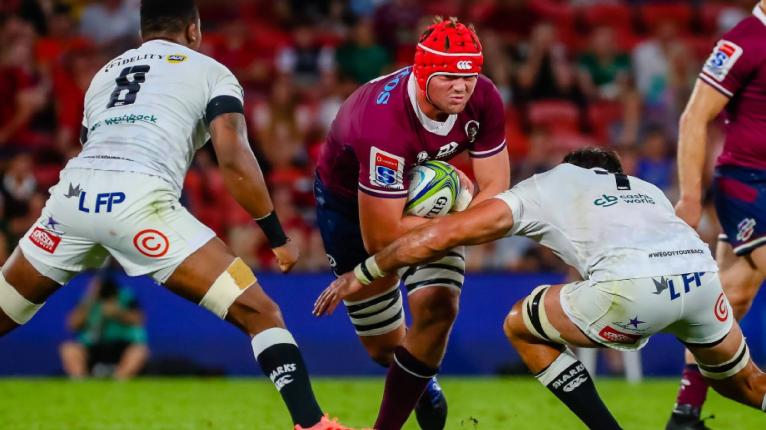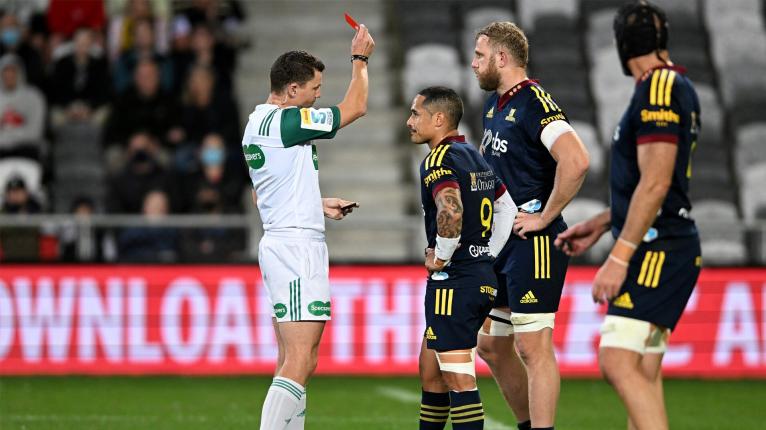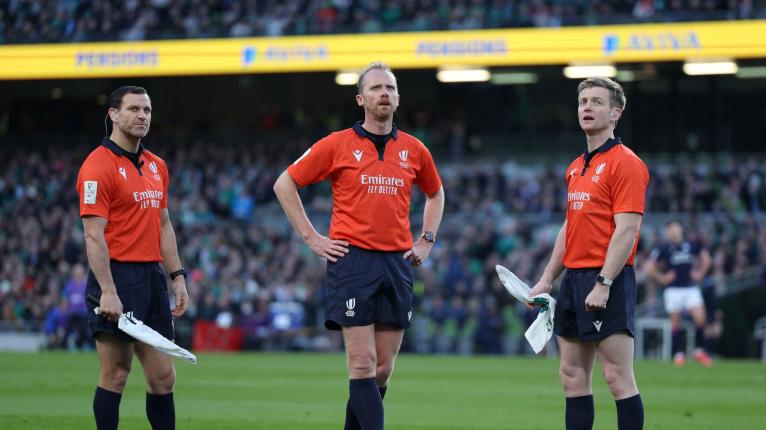Darting halfbacks and rampaging No 8s will be the flavour of Super Rugby Pacific now the competition has turned test tube again for a raft of law experiments.
Just think Tate McDermott and Harry Wilson at the Queensland Reds, redhead Finlay Christie and Hoskins Sotutu at the almost-champion Blues, Nic White and Rob Valetini at the ACT Brumbies and so on.
Why so certain? From Friday night’s kick-off to the Crusaders v Chiefs game, no defending halfback can advance past the midline of the scrum.
The main reason for the law change is to guarantee cleaner delivery of ball from the halfback. There will be no more harassing by a pesky halfback at the base to disrupt attacks from set-piece.
The extra spin-off will be No 8s being unharried when it comes to picking up the ball at the back of the scrum and getting a flying start with their first few strides.

Just listen to the excitement in the words of noted sniper McDermott, a Wallabies halfback whose stocks may rise significantly under new Australian coach Eddie Jones.
“You think of a skilful No 8 like ‘Wilso’ at the back of our scrum and he’s not going to have pressure there,” McDermott said.
“The law change is also inviting running 9s to come to life. There’ll be halfbacks across the comp licking their lips because you can now go either side of the scrum now with an 8-9 play.”
So how do the Australian sides stack up to capitalise on the halfback law tweak which will often-times leave defending No 9s behind the hind-most feet on the offside line?
McDermott has darting in his DNA so his partnership with Wilson off the back can be five-star even behind a Reds scrum that will be nowhere near the dominant force of recent seasons with injured tighthead Taniela Tupou missing for the entire competition.
The Western Force have too many other things to worry about getting right before finesse moves off the back of scrums.
At the Brumbies, it won’t just be Wallaby White utilising Valetini, who was on Thursday named Australia’s Super Rugby Pacific Player of the Year for 2022. Australia A halfback Ryan Lonergan has been picked to start against the Waratahs and one of his trademarks is the short-side dash from ruck or scrum.
The skilful Pete Samu is actually at No 8 for the opener against the Waratahs. He has excellent handling skills so you can see the Brumbies picking different occasions in different parts of the field to use Samu or the blunt force of Valetini off the back of scrums in set plays. The Waratahs have gone with two opensides in their starting backrow for Friday’s clash with the Brumbies in Michael Hooper and experimental No 8 Charlie Gamble, a relatively light 104kg. It’s later in the game that they will sharpen true No 8s Will Harris or Langi Gleeson.
The Waratahs are well equipped with skipper and halfback Jake Gordon at his best when running.
The Western Force have too many other things to worry about getting right before finesse moves off the back of scrums. Nine players will play their first games for the Force against the Melbourne Rebels in Perth on Saturday night in a game Australian rugby hopes isn’t the bottom four duel it looks.
Starting halfback Ian Prior is a fine passer and leader but his 32-year-old legs no longer have a quick burst in them for the Force. New skipper and No 8 Michael Wells is a shrewd worker rather than a line-busting type.

The Rebels have scheming runner Ryan Louwrens at halfback and a journeyman No 8 in Richard Hardwick. It may prove a good partnership.
Forced to pick, the McDermott-Wilson combo looks best equipped to get value from this law change. You can certainly add the Brumbies’ too.
We already know “Eddie Everywhere” will be watching closely. New Wallabies coach Jones will be in Sydney on Friday night and making the flight to Townsville to scrutinise the Reds “live” on Saturday night.
When we start talking law tweaks, it always reminds me of the classic cartoon I’ve kept since it was penned by Garrick Tremain for a New Zealand newspaper nearly 20 years ago.
A top-hat wearing alickadoo at Rugby School poses the question to a young William Webb Ellis.
“You say if we pick it up and run with it, Ellis, then change the rules annually for the next 200 or 300 seasons we might eventually make a new game of it? Are you sure boy?”

Nothing in the two decades since the cartoon was first published has changed in terms of regularly tinkering at the breakdown, with tackle technique and so on. The boffins are still adjusting laws, improving some, misjudging others and having to initiate some just to counter unintended consequences.
But a strange thing has happened as fans expectantly wait for Friday night’s kick-off to the Southern Hemisphere’s showpiece provincial competition; the boffins in charge of these “law variations“ seem to have got a whole lot right this time. They seem to have removed the ear wax and listened to the biggest gripes of fans shelling out their hard-earned cash.
Only properly road-testing the 10 law variations will really prove anything and that’s the intriguing sub-plot to the 2023 Super Rugby Pacific season.
Here are just two that will have fans cartwheeling with joy.
Common sense has reached the dire deliberate knock-on law that had players sin-binned and giving up seven-point penalty tries as an overblown double-whammy.

Now, yellow cards will only be issued for the “extremely cynical” variety.
There were some 40-minute halves stretching past 50 minutes last season because laborious TMO situations were played out on the big screen like a tedious Judge Judy episode.
During Super Rugby Pacific, offenders can be booted from the field with a yellow card. The TMO can then industriously scrutinise the incident from every angle but in the privacy of his own box, not with 20,000 baying fans watching over his shoulder while endless replays go up on the big screen.
Extended TMO reviews will now take place after the yellow-carded player has left the field and not before. The TMO will have eight minutes to either uphold the 10-minute yellow call or upgrade it to red. That makes sense, right? The game keeps moving.
There’s a Shot Clock too, a stopwatch to get lineouts set in 30 seconds. The same goes for scrums. Halfbacks can no longer eat their lunch behind a ruck before deciding on a course of action. They have five seconds.
The law variations will mean more fatigue if the game keeps moving at a faster pace – as hoped.
Props are already reporting that the game just keeps moving and you have to keep up and keep alert.
One of the best spin-offs is invisible. The law variations will mean more fatigue if the game keeps moving at a faster pace – as hoped.
A Richie Mo’unga, Beauden Barrett, Will Jordan, Jordan Petaia or Len Ikitau only has to spy a puffing tight forward and, bang, it’s a dummy, a step and try time.
So exactly what are the main law variations in play with the stamp of approval from World Rugby?
- The referee will put a stopwatch Shot Clock on kickers who will have 90 seconds to kick a conversion from the time a try is awarded, and 60 seconds for penalties, from the time the referee signals a shot at goal.
- Match officials will expect lineouts and scrums to be formed within 30 seconds of the respective marks being set, and the ball to be used within 5 seconds of a ruck being formed.
- TMOs can only ‘interrupt’ play to investigate serious, clear and obvious incidents of dangerous play missed by the Match Official team.
- Referees can utilise the TMO to make a yellow-card decision, but any extended TMO video reviews will take place once the player has left the field, not before the yellow card is issued.
- The TMO will have eight minutes to either uphold a 10-minute yellow-card decision or upgrade it to a 20-minute red card, in which case the player will not return to the field, but can still be replaced.
- Referees will now also have the power to issue a full red card for deliberate foul play, in which case the player will not return to the field and cannot be replaced.

Super Rugby Pacific tournament director Matt Barlow said fan feedback had played a part:
“We’ve listened and taken steps to reduce stoppages and video replays, increase flow and maintain the integrity of the competition and the safety of players in regard to yellow and red cards.
“We want Super Rugby Pacific to be the most entertaining, innovative and fastest professional competition in the world.”
As with all law variations, they mostly look good on paper. Now let us see how those nutty professors of rugby, our coaches, use the law tweaks to their advantage.


Wonderful insightful article 👌
What's the point of these law changes in a world cup year if they're not widely adopted? Halfbacks can't advance beyond the midline of the scrum - so what, it's a false dawn. Everything reverts back for tests so all those habits developed during Super rugby are irrelevant.
What does almost champion mean? The blues barely got to the final winning by 1point and through controversy and were put in their place by the 6 TIME CHAMPIONS ...will all the blues fans sit down please